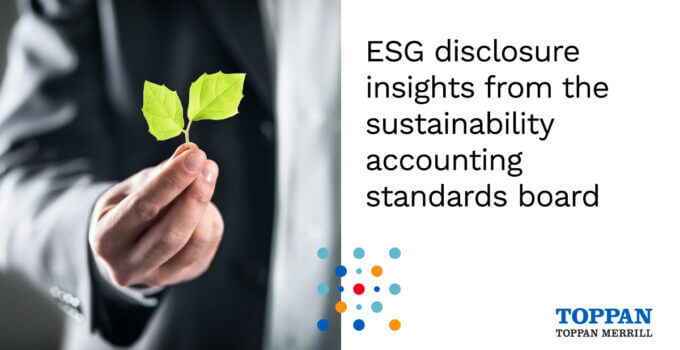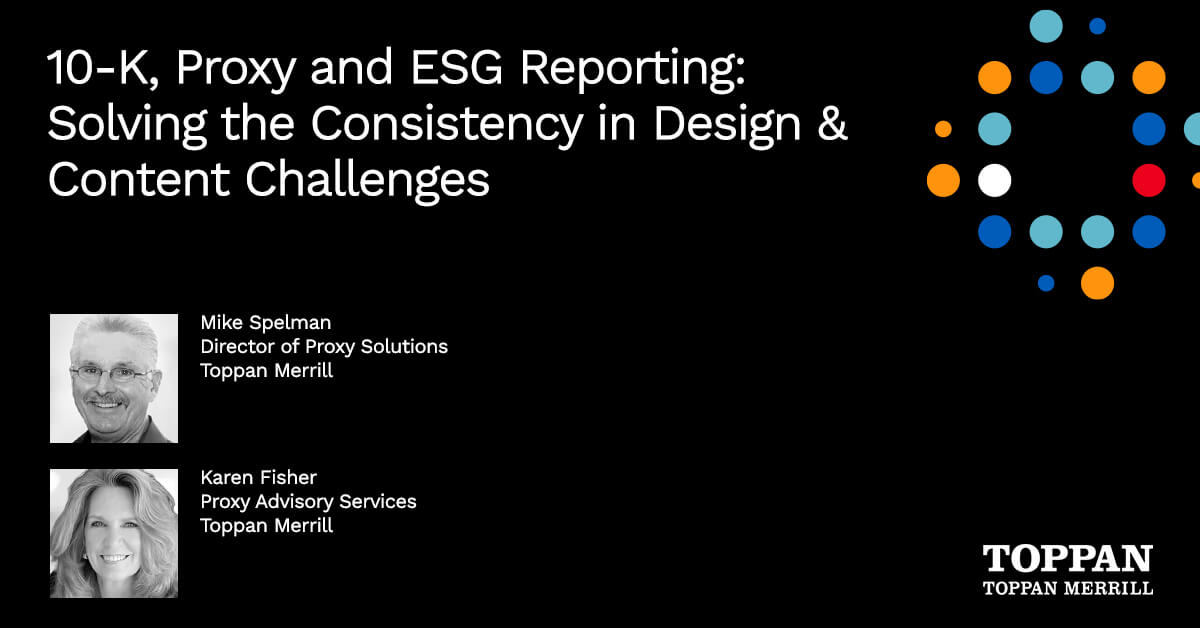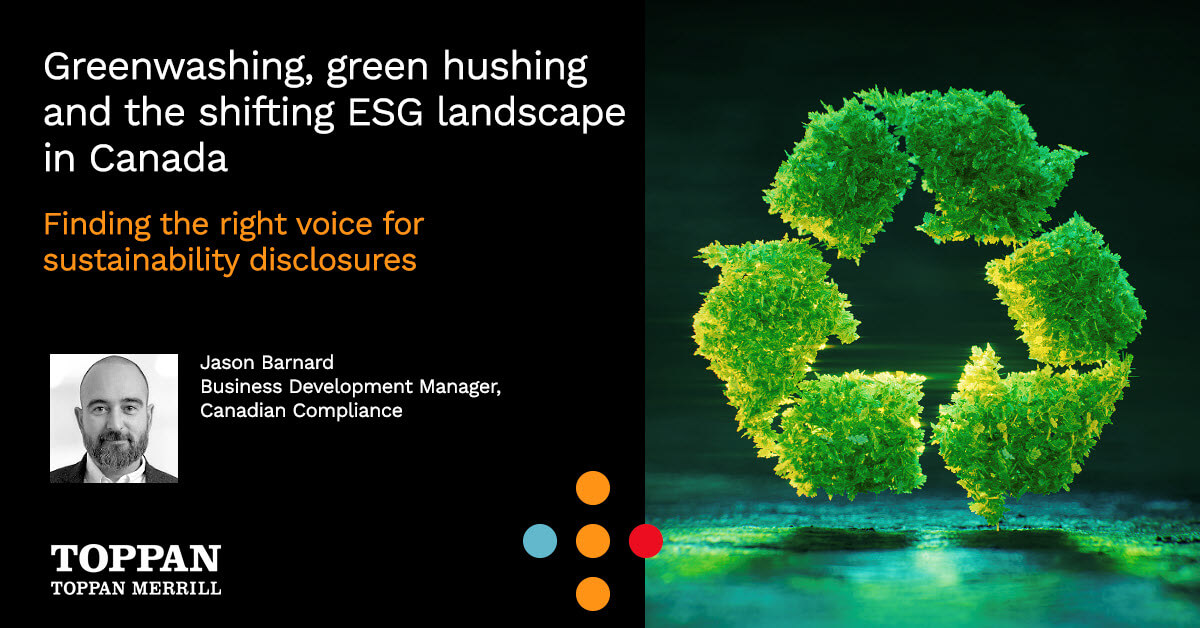Under the administration of President Biden, the SEC will probably consider requiring disclosures in several environmental, social, and governance (ESG) areas. Public companies in the United States may have to disclose data on specific climate-change risks, which are currently reported only voluntarily and often outside SEC filings.
The Sustainability Accounting Standards Board (SASB) has taken a lead role in setting standards for voluntary ESG disclosure. Dimensions asked Madhu Mathew, SASB’s Director of Technology, for insights into SASB’s standards, its promotion of structured data and XBRL tagging, and its role after the SEC mandates more specific ESG disclosures.
Sustainability & ESG Disclosures
What is meant by “sustainability” and “ESG disclosures”? Are they the same?
The concept of sustainability (or, more specifically, sustainable development) is defined in the Brundtland Report (Our Common Future) as “development that meets the needs of the present without compromising the ability of future generations to meet their own needs.” In the context of companies, we can think of sustainable performance as firm operations that maintain or enhance firm value today without compromising the ability of the firm to create value in the future. SASB’s use of the term “sustainability” refers to activities that maintain or enhance the ability of the company to create enterprise value over the long term.
Sustainability issues can be related to the environment (E), society (S), and corporate governance (G). In that sense, the two terms are similar, but sustainability is used in a broader sense. The capital markets tend to use the term “ESG” as it provides a certain specificity to the issues that they are referring to in the context of long-term enterprise value creation.
SASB
What is SASB, and what is its role related to these disclosures?
SASB is a nonprofit standard-setting organization. We establish industry-specific disclosure standards across financially material environmental, social, and governance topics. We envision an investment universe where a shared understanding of companies’ sustainability performance enables companies and investors to make informed decisions that drive improved sustainability outcomes and thereby lead to improved long-term value creation.
Disclosure Standards
What type of disclosure standards does SASB suggest, and why are they industry-specific? Are they similar to accounting standards?
Sustainability issues affect industries differently. For example, a company in the insurance industry might have very low Scope 1 greenhouse gas emissions because its operations are mostly situated within office buildings. But if the company has insured assets in areas prone to extreme weather events, then its risk exposure to climate change may be very high. That is precisely why SASB’s Insurance Standard has a disclosure metric (FN-IN-450a.1) related to environmental risk exposure.
Market value typically differs from book value, in part because traditional financial statements do not necessarily capture all the factors that contribute to a company’s long-term ability to create value. Much of this “value gap” is attributable to or can be significantly impaired by the management or mismanagement of environmental, social, and human capital as well as corporate governance. Therefore, corporate disclosure must extend beyond financial statements to facilitate the measurement and reporting of sustainability information that will enhance a decisionmaker’s understanding of all material risks and opportunities.
Like financial accounting, sustainability accounting has both confirmatory and predictive value, so it can be used to evaluate past performance and be used for future planning and decision support. As a complement to financial accounting, it provides a more complete view of a company’s performance on material factors likely to affect its ability to create long-term value.
Financial accounting addresses some elements of sustainability performance. However, financial accounting is intended, for the most part, to reflect an entity’s current financial condition and financial performance.
Assessing the financial impact of sustainability issues is inherently limited by the absence of proper valuation techniques and/or adequate market pricing. While environmental, human, and social capitals can be understood conceptually as economic assets and liabilities, the lack of comparable data makes accounting for these sustainability factors challenging—a deficiency that the SASB Standards are built to address.
Disclosed Material Information
How does SASB determine what is material information that should be disclosed?
The SASB Standards address the sustainability topics that are reasonably likely to have material impacts on the financial condition, operating performance, or cost of capital of companies in an industry. SASB recognizes that each company is responsible for determining what information is material and what information should be included in its disclosures. In identifying sustainability topics that are reasonably likely to have material impacts, SASB conducts extensive research to identify evidence of financial impact associated with sustainability issues and evidence of investor interest in those impacts.
For each disclosure topic identified in an industry, SASB selects or develops decision-useful accounting metrics to account for company performance on the topic. Accounting metrics address sustainability impacts, as well as opportunities for innovation. Taken together, they characterize a company’s positioning with respect to sustainability issues and the potential for long-term value creation.
Voluntary or Mandatory
Are the SASB disclosure standards voluntary or mandatory for issuers (i.e., companies)?
SASB-based disclosures are voluntary. However, several regulatory jurisdictions have either recommended or are in the process of recommending the use of SASB Standards for disclosing financially material ESG information. Investors see the value in the standards and have recommended and encouraged companies to disclose using them. As a result, we are seeing rapid growth in voluntary SASB-based reporting, with 542 reporters in 2020. The following graph provides more details about the growth.
SASB Standards in Different Industries
How do the SASB Standards further comparability in disclosures among companies in different industries?
Companies operating in the same industry are likely to have similar business models and, therefore, similar sustainability risks and opportunities. As a result, SASB develops sustainability disclosure standards at the industry level, focusing on issues that are closely tied to resource use, sustainability impacts, business models, regulation, and other factors at play in the industry. Industry specificity results in metrics that are comparable, as it allows users to identify which companies have similar versus different performance in an industry on a particular sustainability topic.
The SASB Standards also include activity metrics, which quantify the scale of a company’s business and are intended for use in conjunction with sustainability accounting metrics to normalize data and facilitate comparison.
Your question is about comparing disclosures among companies in different industries. The SASB Standards are not really meant for such cross-industry comparison. While issues like climate change and issues related to human capital cut across industries, they manifest differently from one industry to another. So, an industry-specific approach tends to be more useful from a risk management perspective.
Sustainability Reports
Are the sustainability reports separate or integrated as part of another corporate or SEC report?
We are seeing SASB disclosures occurring in many different reports. The majority of the disclosures occur first in corporate sustainability reports and/or independent reports called ESG Release or SASB Report. But we are also seeing them in integrated reports and annual reports as well as regulatory filings. (An integrated report is one based on the principles developed by IIRC.)
Correlation with Financial Health
Do disclosures on sustainability correlate with a company’s financial health?
Research supports that idea. In Corporate Sustainability: First Evidence on Materiality by Mozaffar Khan, George Serafeim, and Aaron Yoon, the authors find that firms with good ratings on the disclosure topics identified in the SASB Standards significantly outperform firms with poor ratings on these issues. In contrast, firms with good ratings on “immaterial” sustainability issues (e.g., ESG issues not identified by SASB for a given industry) do not significantly outperform firms with poor ratings on the same issues. Lastly, they find that, with all else being equal, firms scoring at the top quintile on the material issues have higher future return-on-sales growth.
Several research papers on SASB have been published and are available on our website. Readers will find them very interesting.
One other interesting thing I would like to mention is that the very idea of SASB was first introduced by the Initiative for Responsible Investment at Harvard University in a white paper co-authored by our founder, Jean Rogers: From Transparency to Performance: Industry-Based Sustainability Reporting on Key Issues.
Specific Disclosures
Does the SEC also have these types of specific disclosures on ESG?
No, the SEC does not have these types of specific disclosures. The SEC recently issued its long-awaited amendments to Regulation S-K. The rulemaking includes a new requirement that public companies disclose information about “human capital resources” in these filings. The final rule is principles-based rather than prescriptive.
SASB supports a principles-based approach, and we submitted a comment letter to that effect. But we also stated that, in order for a principles-based rule to result in consistent and comparable company-to-company disclosures, the SEC would need to refer to a disclosure framework or standards; hence we recommended that the SEC either strongly urge or require companies to make disclosures pursuant to an ESG framework that—like SASB’s—has been developed through due process, is based on financial materiality, and is intended to meet the informational needs of investors.
Requirements
Does SASB anticipate that the SEC will propose and adopt more specific sustainability/ESG reporting requirements? What does SASB anticipate will be the top ESG areas for SEC rulemaking?
We have continued to stay engaged with the SEC. In our public comment to the SEC on Regulation S-K, we requested that the SEC consider referring to the SASB Standards as a useful tool for making consistent, comparable, reliable sustainability disclosures in regulatory filings. There does appear to be some urgency at the Commission to enhance disclosure to investors regarding climate risk, and it seems more likely that the SEC may prioritize that work under the incoming administration.
If the SEC does require more specific ESG disclosures, such as on climate change, how do the SASB Standards fit into them?
Climate change does not affect every industry in the same way. The SASB Standards enable companies to disclose climate-change-related data that helps investors better understand how companies are performing in regard to the climate-change-related impacts and drivers most closely related to their business model. For example, in the automobiles industry, it is fuel economy; and in the insurance industry, it is risk exposure to physical effects of climate change.
Other Countries
Are there regulatory bodies in other countries and stock exchanges using the SASB disclosure standards? How do the SASB Standards work together with the local requirements?
Yes, there are several regulatory bodies across the world that are either considering recommending or have already recommended using the SASB Standards. In Japan, the Philippines, and the UK, regulatory authorities have noted that SASB Standards can be used. In Canada, the European Union, Taiwan, and New Zealand, consultations are underway. There are 27 stock exchanges around the world that recommend the use of SASB Standards.
Certain local jurisdictions may require additional disclosures for the achievement of specific policy objectives. SASB recognizes the importance of jurisdiction-level overlays, which can ensure that global standards from
SASB are complemented by any additional disclosure requirements needed for achievement of such specific policy objectives.
Structured Data & XBRL Tagging
The SASB created its own taxonomy for XBRL. Why is SASB now promoting structured data and XBRL tagging for its disclosure standards? What does this show about the acceptance and demand for this type of structured disclosure?
There is growing demand from investors for SASB disclosures. Now there is a growing supply of SASB disclosures from companies. XBRL is a mechanism by which disclosed data can be distributed efficiently, accurately, and in a timely manner. By making SASB-aligned data readily and widely available, the capital allocation and investment decision can be made based on relevant and necessary ESG information. That is fundamental to the SASB mission.
Why is making sustainability disclosures available in a structured format (e.g., XBRL) better for issuers and investors?
When disclosures are available in a structured format, it becomes easy to collect and aggregate the data. It makes complex AI and other human-based collection of data unnecessary. It also ensures that data being collected is accurate. The information supply chain becomes more efficient, and the time between when a company discloses and when that information becomes available within investor analytics tools and terminals will be greatly reduced. Issuers benefit because the information gets into the hands of the investor quickly and accurately. Investors can then use this information with greater confidence in making decisions.
Are SASB’s XBRL standards similar to the SEC approach to XBRL? If the SEC adopts mandatory ESG disclosure and requires XBRL tagging as part of it, how would SASB’s structured-data standards work with it? Would they interact and co-mingle together in some way or be separate?
SASB’s XBRL taxonomy is built very similarly to how GAAP taxonomy is built. Our hope is that the SEC approves the SASB taxonomy and allows filers to use the SASB taxonomy to tag SASB disclosures.
Would preparing SASB disclosures and XBRL tagging change the process of preparing financial reports for issuers?
Our recommendation is that preparing SASB disclosures should follow essentially the same process that companies currently use for financial reporting. Given the financial materiality of the information, it should have a robust review and verification process. We are working with leading filing software providers to integrate SASB XBRL taxonomy into their platforms. Once integrated, the goal is to make SASB reporting as seamless as possible to the existing process.
Value Reporting Foundation
Why did SASB and the International Integrated Reporting Council (IIRC) decide to merge into a new organization, to be called the Value Reporting Foundation? Will this lead to any changes in the current SASB disclosure standards?
The Value Reporting Foundation will merge SASB and IIRC into a credible, international organization that maintains the Integrated Reporting Framework, advocates integrated thinking, and sets sustainability disclosure standards for enterprise value creation. The merger directly responds to calls from global investors and corporations to simplify the corporate reporting landscape, providing the market with a clear solution for communicating about the drivers of enterprise value.
Barry Melancon, chair of the IIRC Board, articulated it best: “The Framework and the SASB Standards are complementary. Integrated reporting describes all relevant value creation topics and the approach to integrating them in corporate thought and reporting. SASB provides the precise definitions of the data that should be reported for these topics in each industry. Organizations globally already use both to communicate effectively with investors about how sustainability issues are connected to long-term enterprise value, with these endeavors ultimately benefitting other key stakeholders. Under the Value Reporting Foundation, we will link the concepts between the Framework and SASB Standards even further.”
To read the full article in Dimensions Vol. 2021, No. 1, click here.
Reach out to jump-start a partnership that will bring speed, security, accuracy, and efficiency to all of your complex content and communication requirements.



